Discover Italy
By Janet B. Scraper
Fall is a glorious time to visit Italy, and in October 2010, I accompanied some of my clients on a 10 day, small group, Culinary and Wine Tour of Tuscany (and more), that I created exclusively for Arrow Discovery Travel. After the tour, I extended my stay another week, to indulge in more of the pleasures of Italy. The pictures shown are mine (except aerial view of Siena and Monteriggioni)
Florence
We began our tour in Florence, where the Renaissance began. We stayed at a beautifully restored Palazzo, turned hotel, in the Oltrano, the south side of the River Arno, just a couple blocks from the Ponte Vecchio and the Pitti Palace. The hotel was on the Piazza Santo Spirito, pedestrians only, which gave us the experience of living among the neighborhood residents.
The Piazza is built around the Santo Spirito church, outwardly plain, but inside the space is filled with light and grandeur. The church is one of the architect Brunelleschi’s masterpieces, and is worth a visit. Each morning, merchants set up a market, where locals come in droves to buy fresh produce, flowers, clothing, household items and everything in between. There are half a dozen restaurants and cafes in the square, where the neighbors meet to share a coffee or grab a quick lunch. We found a little gem in the Osteria Santo Spirito. We were the first ones seated at 7 pm, but soon the place was packed with a lively local crowd. We started with a bottle of wine and a big pot of succulent and savory mussels, followed by more wine and an assortment of starters (pasta) and main dishes. We intended to share, but once a plate was in front of us, we selfishly kept most of it for ourselves, sharing only a taste. This would be the start of our gluttonous wine and food exploration of Italy.

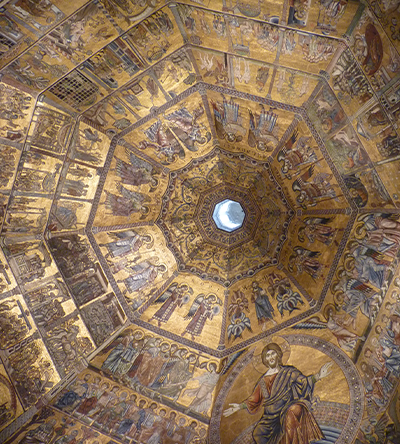
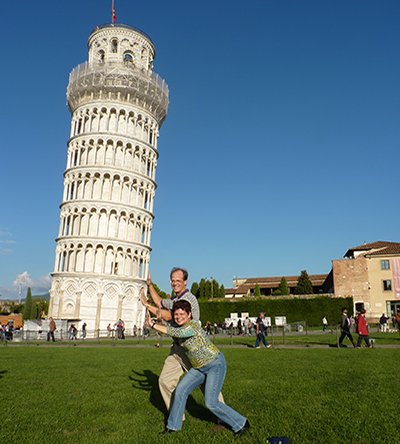
We_only had 2 days in Florence (not enough) visiting as many of the iconic sites as we could. We walked across the Ponte Vecchio to the Piazza della Signoria, the most famous square in Italy. It is an open-air museum of statuary dominated by a copy of Michelangelo’s David and the Palazzo Vecchio. Of course we had to see the original David so we had advance skip the line tickets for the Accademia and for the Uffizi Gallery, one of the world’s greatest museums. The symbols of Florence are the Duomo and Baptistery; the exteriors are absolutely massive and equally majestic with stripes of white, green and pink marble. Both were undergoing a thorough cleaning and now the beauty of the workmanship really shines. Walking along the river Arno, we noticed thousands of locks hooked to every imaginable surface, and wondered what the purpose of them was. We would see them again in another place and learn the story, which I will share with you later. Along the way we ate many gelatos, enjoyed more of the local wine and food and discovered that you MUST have dessert with every meal in Italy. The restaurants have a display case in a high traffic area, so you can’t miss seeing these beautiful creations and realizing that to try them all, you have to eat one at every meal. As I mentioned, this was not a trip to worry about dieting, you can do that before and after your visit to Italy. There just happened to be a huge wine show going on while we were there, so we bought a few bottles of Chianti Classico to enjoy while sitting on the spacious verandah of our hotel in the evening, before and after dinner. We realized we had only scratched the surface of Florence and vowed to return for a more in depth exploration.
Pisa
Too quickly, our time in Florence was over, on the 3rd morning our driver, Lauretta, picked us up at the hotel, and we headed off to Pisa. The first sight of the Campo del Miracoli does take your breath away, it is truly stunning. The three exquisite buildings, the Cathedral, the Baptistery and the Bell Tower (the leaning tower of Pisa), are set on a spacious green park (Campo), creating a stark contrast to the white marble buildings and allow for a 360 degree view, so uncommon in the cramped city spaces. After a pizza lunch, we took a guided tour of the Cathedral and the Baptistery and learned the marble used to construct the buildings (1063-1350) was stolen mostly from the ruins in Rome and repurposed. If you look closely you will notice that the exterior marble pillars of the cathedral are a mix of styles and colors. You learn the work force was illiterate as some of the marble blocks reused on the sides of the buildings have words that are upside down. The adventurous of us climbed to the top of the Leaning Tower of Pisa where you can see the six huge bells and enjoy a panoramic view of the city of Pisa and the surrounding country side. We had hoped to have time to see more of the city, but we spent too much time climbing the tower and trying to get “THE photo” of us holding up the tower, so we had to move on.
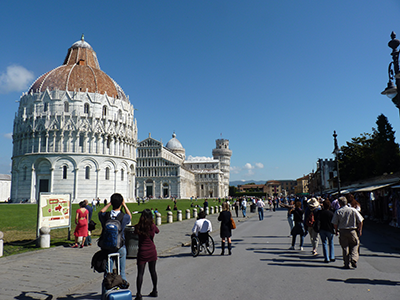

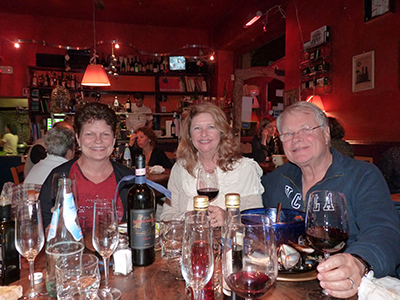
Home Sweet Country Home
We headed NW from Pisa towards the beach resort town of Viareggio, in the Versilia area of Italy. Our home base for the next five nights was a country house in the hills above town. We were greeted by the owner Massimo, who had lovingly renovated a ruin into a 6 bedroom, 5 bath, bed and breakfast. It is officially named an Agrituristica, because it sits on a working farm, with olive groves and vineyards. There is a nice pool and lounge area a few steps from the house that overlook the rolling hills that go down to the coast. After Massimo gave us the tour and we settled in, we were treated to a five course Tuscan meal, prepared by a local chef. It was WONDERFUL! Typical Tuscan fare is simple food made from what is fresh from the farm and varies by season. My favorite dish was the Bread Soup, which we would learn to prepare later in the week during one of our two cooking lessons with a world renown master chef. We had had a full day and full tummies, so we went to bed early, to re-energize for the week ahead.
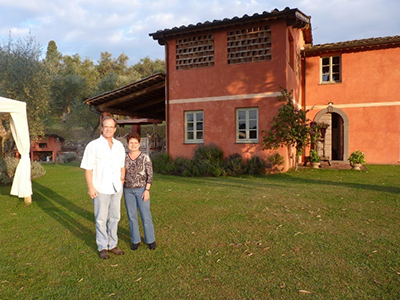


The next morning at breakfast, we met Irmi, a beautiful, 31 year old Austrian woman, who would be our driver/guide for the week. After living in this area for years, she had just returned from a 2 year stint in London as a nanny and was eager to keep up her flawless English. She had fallen in love with this area and has made it her home. Over the course of the week, we would learn that in addition to being a certified guide of Versilia, Liguria and Tuscany, she had quit school to join a ballet company in Milan, played half a dozen musical instruments at a professional level and was fluent in many languages. She was an absolute professional and down to earth at the same time. We loved the witty sense of humor she had picked up in London and were pleased to learn she understood our “American-English slang.” We fell in love with her immediately. Soon we were off to spend the day in Cinque Terre in Liguria, the coastal region. While a little off the path of Tuscany, Cinque Terre has long been on my bucket list, so since we were this close, I added it to the itinerary.
Cinque Terre
We were lucky enough to have a beautiful blue sky and calm waters, so we were able to take the boat both to and from Cinque Terre. We left from Lerici which allows for an incredible view of the entire peninsula with the picturesque town of Portovenere across the bay. I recommend taking a boat to Cinque Terre if at all possible as it is the only way to get the characteristic photos of the towns nestled into the hillside is from the sea.
Collectively, the five villages that are Cinque Terre, is a Unesco World Heritage Site and a National Park. This status has allowed the preservation of the villages in near original condition. Cars and motor bikes are not allowed in the villages; you can take the train between them or walk. Riomaggiore, Corniglia, Manarola, Vernazza, Monterosso are the five villages that form the Cinque Terre, suspended between sea and land on sheer cliffs upon the beautiful sea. The vineyards, typical of this area, have contributed to create a unique landscape with dry-laid stone walls, winding paths and enchanting beaches between cliffs and clear waters. The streets of the towns are very steep and the houses, built wall to wall, are painted in lively colors with the day’s laundry hung to dry off the balconies.
Our first stop was in the village of Riomaggiore and from there we took the Via del ‘Amore to the next village of Manarola. Again we saw thousands of locks, and here we learned the story. In the 1920’s the path was built between the villages, connecting them for the first time. It became a meeting place for lovers living in the towns on each end and the inspiration for a couple of romantic novels. One of these stories introduced a lover’s rite in which a man trying to win the heart of a girl put a lock on an old bridge in Rome and thru the key into the river to show his love would last forever. The novels inspired a movie and now, all over the world, lovers put a lock on a railing and throw the key into the water as a promise of everlasting love.
After a tour and lunch in Manarola, we took a boat to Monterosso, the largest village, with many lemon trees and the only “extensive” sand beach in the Cinque Terre. We ended our tour in a winery above the village, for a wine tasting in the most scenic setting. The owners had prepared many delicious appetizers to go with the wine, and the whole family came out to contribute to the story of the vineyard. We ended the tasting with the winery’s Limoncino, made from the local lemons. Limoncino is from northern Italy and Limoncello is from southern Italy, the subtle difference is in the taste of the lemons. After stocking up on wine and Limoncino, we headed back to Lerici and were rewarded with a beautiful sunset to end our day. Irmi dropped us off at a local seafood restaurant in Viareggio, where Massimo introduced us to the owner and ordered our wine and dinner for us. No English spoken here. We are not sure what everything was, but it was all fresh from the sea and skillfully prepared. This was truly an authentic Italian experience.
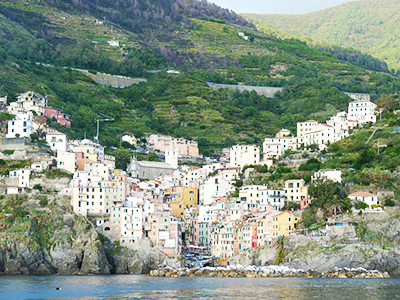
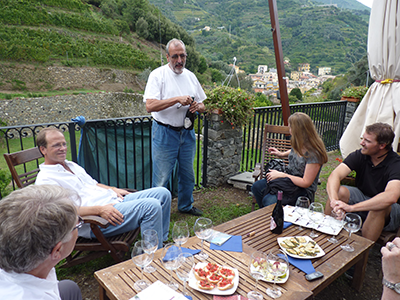
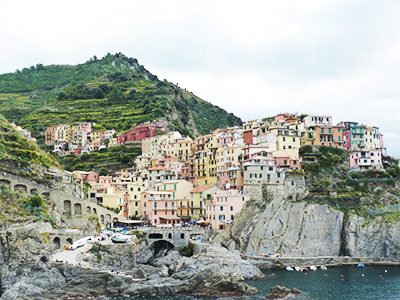
Northern Tuscany
Over the next few days we visited Lucca and Montecarlo, had a wine tasting at a vineyard with another fabulous view and superb appetizers, went to Pietrasanta, an artist town where they carve the famous white Carerra marble found only in the nearby quarry, Viagreggio the resort town, and the hill towns of Camaiore and Casoli. We had a cheese tasting and an olive oil tasting hosted by the owners of the farms they were produced, a chocolate tasting and two cooking classes at our country house where we learned to prepare authentic Tuscan dishes, including handmade pasta. We ate everything we made, pairing each meal with a local wine. After our last day of touring this region, we met Massimo’s parents on our return to the house. Massimo’s dad came over to make the fire for the forno, a stone, wood fired outside oven. This is a special skill, perfected after years of practice. Tonight we had a “Pizza Man” Diego, to teach us how to make pizza al forno. He brought about 30 balls of dough and every fresh ingredient you could imagine (and then some). Getting the pizza dough just right was a lot harder than it looked! We each took turns making our own pizza creations and we learned that the men were much better handling the wooden pizza “paddle” and the women were better at making an even, roundish pizza crust.

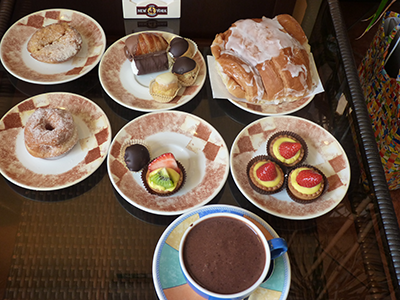
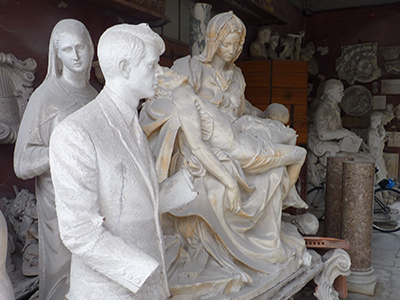
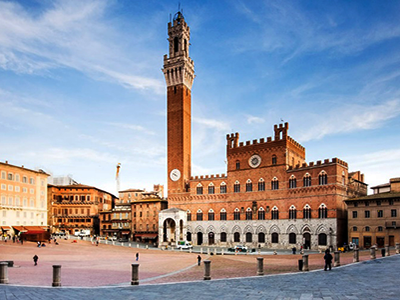
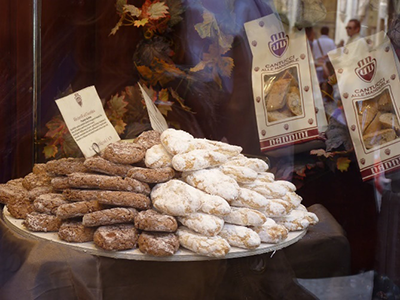
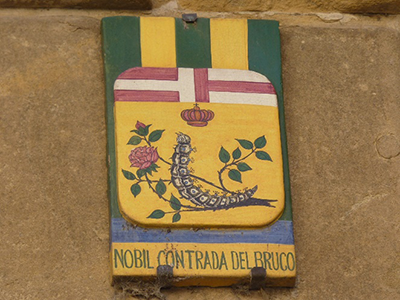
Finally it was time to leave Massimo and Irmi, by now our dear friends. Again, Lauretta, picked us up and we headed south into the heart of Tuscany. Lauretta, is from the area around Siena and works as an administrator of a winery. She would be our guide for this portion of the trip.
Our home base was another agriturismo, this one with the most spectacular view yet. There was a big flower laden trellis and patio overlooking the pool area, with the towers of the medieval town of San Gimignano perched on a hill, not too far in the distance. Surrounding the town were rolling hills filled with crops intersperse with trees. It was breathtaking! We wanted to stay and relax a while, but we had a full day planned and headed off to Siena.
Siena – The Gothic Dream
Siena stole my heart and soul. I left a little piece of me there, so I could go back and visit it again. It is hard to describe the magic of Siena. The neighborhoods with the mascots of the contradas, the ancient public space of the Piazza del Campo with the Palazzo Pubblico, the bakeries which sell freshly made traditional sweets, the magnificent Cathedral, and the vista from the city walls, together set a historical stage behind the everyday lives of the people who live there today. The passionate history of Siena is an important part of the magic that still exists today.
Siena is an ancient city, dating back to the Etruscans (900-499 BC). By 900 AD a trade route running from Rome to France was established and Siena became a major stop over point. A number of settlements sprung up along the route that were eventually incorporated into the city. Florence and Siena fought many battles for superiority. By 1300 Siena was very wealthy and the social structure and most of the city’s important monuments were being built, including the Piazza del Campo and the Cathedral. The final result we can see today. The city is like a living, breathing piece of history. You can imagine the spirits from residents over the centuries, still wandering around in another dimension.
One of the most fascinating things about Siena is the continuing social importance of the Contrade. A contrada (plural: contrade) is a district, or a ward, within an Italian city. The most well-known contrade are probably the 17 contrade of Siena that race in the Palio di Siena. Each is named after an animal or symbol and each with its own long history and complicated set of heraldic and semi-mythological associations.
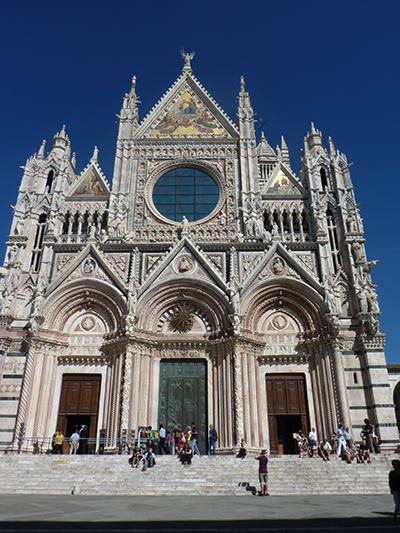


These districts were set up in the Middle Ages in order to supply troops to the many military companies that were hired to defend Siena. As time has gone by, however, the contrade have lost their administrative and military functions and have instead become simply areas of localized patriotism, held together by the emotions and sense of civic pride of the residents. Their roles have broadened so that every important event – baptisms, deaths, marriages, church holidays, victories at the Palio, even wine or food festivals – is celebrated only within one's own contrada.
When you are taking a guided tour of Siena, your guide should point out the coat of arms on the corners of streets that define the borders of the Contradas. Every contrada has its own museum, fountain, baptismal font and motto. If you look closely as you walk through one, you will see statues and other symbols of their mascot and coat of arms. It is these Contrade that compete in the Palio, the famous horse race that takes place in Siena’s Palazzo del Campo in July and August. The Palio today can be traced back to the 1200’s and is associated with the celebration of the Assumption of the Madonna, the patron saint of Siena. The social and religious history is totally intertwined, which brings me to the Cathedral.
The Cathedral of Siena is one of the most magnificent in the world. Like the Campo, it is a cherished and famous place for the people of Siena. Like most of today’s cathedrals, the present day structure was built on the site of an existing place of worship dating back to at least medieval times. The Cathedral was consecrated in 1179 and work on the exterior continued until the mid 1200’s, when work began on the interior. It was from then on that the greatest artists of every period began the centuries-long task of enriching the Cathedral of Siena, finally transforming it into an enormous treasure chest, full of the finest and most prized masterpieces.
The best time to visit the Cathedral of Siena is in September and October when the floor,” the most beautiful, great and magnificent paving ever made” is totally uncovered. The task of decorating the floor began around 1369 and was completed in the 1800’s. The entire floor of the Cathedral is covered in marble, using two basic methods, “commesso “and “graffito” to create the designs. There are 56 scenes embodying an actual doctrinal text which reveals a complex account made through allegoric, civil, mythological, philosophical and theological religious motifs from the old and new testaments. Every one of the 56 scenes is worthy of a stylistic description, but space does not allow for that here.


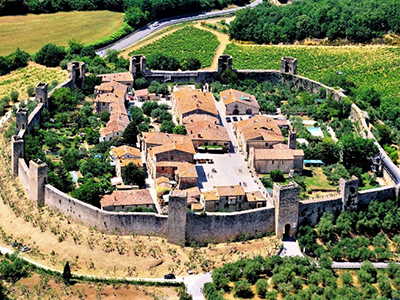
A description of all the treasures inside the Cathedral would take volumes. Be sure to look up at the ceiling and all the detail at the tops of the iconic white and black marble columns. Make sure you don’t miss seeing the Pulpit, an outstanding piece of marble sculpture, the many chapels, the choir, and the Piccolimini Library. Built to honor the memory of Pope Pius II, the library is off the left side the church. It is truly incredible, with the colorful frescos covering the walls which tell the story of the life of Pius II. The ceiling is spectacular and there are many other exceptional works of art within. Do not miss it. You could spend days inside the cathedral trying to assimilate all the art and history present there. Also, make sure you see the Baptistery and the Museo dell’Opera, which houses many original works of art that today have been replaced with replicas for preservation.
More to see and do
We had to pull ourselves away from Siena, as there was much more to see today. Our next stop was a wine tasting at a Relais and Chateaux property which was a posh resort tucked in among the vineyards. The setting was a lovely old village with stone buildings covered in flowering vines, an old well, a chapel, and the accommodations were in restored villas. The walkways were gravel paths lined with huge pots of flowers and benches under shade trees. It was like being in a fairy tale. Here we had a most extensive and exclusive collection of wines to try, cleansing our palate on locally made cheeses and sausages. Our host was the vineyard’s business manager and the executive chef of the resort stopped by to meet us.
After the wine tasting we visited Monteriggioni, an intact, medieval walled town built around 1214 by the Sienese as a front line in their wars against Florence.
Next we headed to San Gimignano, the walled medieval hill town, famous for its towers. In ancient times, wealthy families in many towns built high tower houses to indicate their importance. Most of the towers of Florence and Bologna have either fallen or been razed, but San Gimignano still has 15 of the 72 original towers. The town is still fairly intact with many churches, monuments and museums, including the museum San Gimignano1300, which offers a massive reconstruction of the city as it existed 700 years ago. Architects, historians, and a team of artists worked nearly 3 years to create this spectacular and unprecedented exhibition. This exhibit includes 800 meticulously handcrafted structures, 72 towers, street scenes, and figurines. There is also a lot of cute shops with local crafts, some of it quite expensive. I regret that we did not have enough time to thoroughly explore this splendid example of a medieval city.
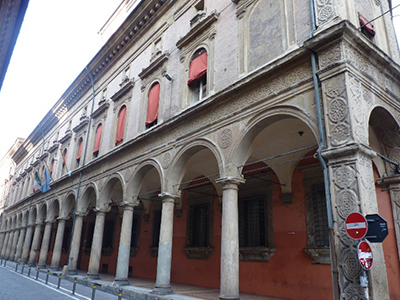

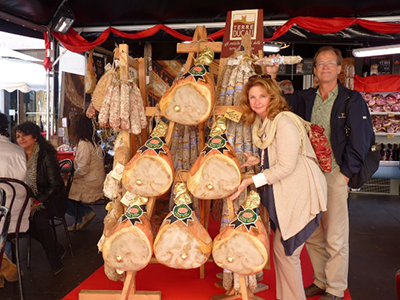
When we returned to our agriturismo, it was getting dark, and we could see San Gimignano on the hill, beautifully lit up for night. Dinner was served family style at a big long table with the other guests. Our final meal of typical Tuscan cuisine was prepared during a cooking class by some of the guests and we toasted to the wonderful food and new friends with many bottles of wine made on the premises.
The next morning the tour was over, but some of us stayed in Italy a while longer. As we were on a culinary quest, we spent 3 nights in Bologna with a visit to Parma, both enchanting towns. While this area is known for its sauces, ham and cheese, there are many artistic treasures to be seen. Bologna is primarily a bustling university and business center and Parma is a lovely small Italian town, also with a university. There are few tourists in either. After a day strolling around Parma, we decided we had to live there one day.
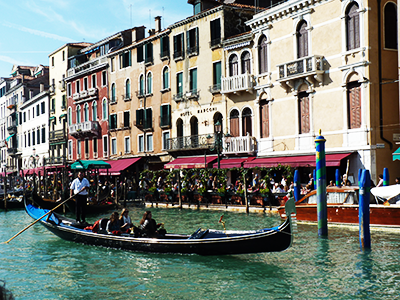
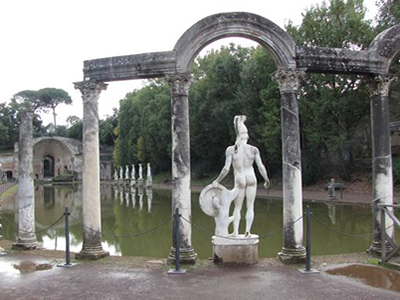
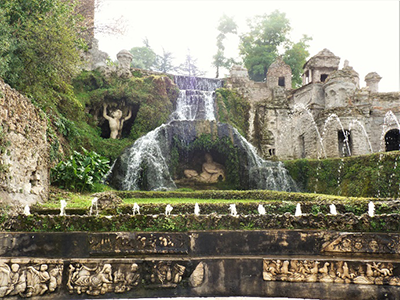
By now our group was down to two. We took the train to Venice for a couple days and then the train to Rome. Since both of us had been to Rome before, we took the opportunity to venture out of town and see Tivoli and Hadrian’s Villa, to explore the Crypts and Catacombs and make a day trip to visit the Palace of Caserta near Naples. Of course we had to re-visit all the famous sites of Rome, and from our centrally located hotel everything was within walking distance. Obviously there much to see and do in Venice and Rome, but that story will have to wait for another day.


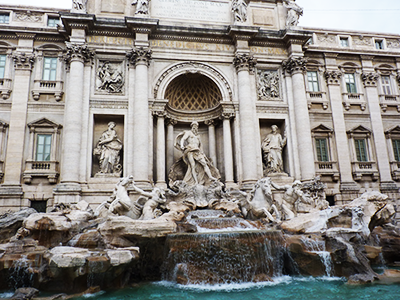
After almost three weeks in Italy, we had covered a lot of ground. We tasted wine and cuisine from many different regions, saw some of the most treasured art and architecture in the world and learned a lot about the history of Italy. We visited many different geographic areas, showing us the diverse and always breathtaking, landscape within Italy. We spent quality time with the “real” Italians, sharing their homes, their food and their family stories. And we learned that you can never spend enough time in Italy, there is always more just around the bend.
Contact Arrow Discovery Travel to help you find the experience best suited for your party.
Janet Beazley Scraper, ECC, CTP
janet@arrowdiscoverytravel.com
954-525-7753
Seller of Travel Numbers
FL 17873
CA 2063964-50
WA 602232785
IA 686
CHARTERS/CRUISES
Private Yacht Charters
Small Ship Cruises
River Cruises
LAND VACATIONS
Resort Vacations
Custom Alaska
Custom Hawaii
Villa Retreats
Land Tours
FEATURED VACATIONS
Featured Vacations
Active Vacations
Dude Ranch Vacations
RV Adventures
Scenic Rail Tours
TRAVEL RESOURCES
Personalized Travel
Travel Style
Travel Articles
Blog
Extraordinary Experiences Magazine
Vacations Magazine
The Travelers Table Magazine
Know Before You Go
CONNECT WITH US
Trip Request
The Value of Using ADT
Travel Trends Newsletter
About ADT
Contact Us